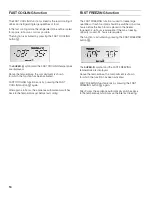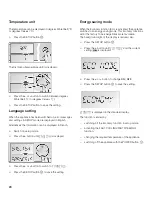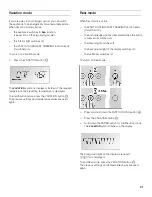
6
GROUNDING INSTRUCTION
This appliance must be grounded. In the event of a mal-
function or breakdown, grounding will reduce the risk
of electric shock by providing a path of least resistance
for the electric current.
Improper connection of the equipment grounding conductor
may result in electric shock. Have the appliance checked by
a qualified electrician or service technician if you are in doubt
as to whether the appliance has been properly grounded.
Some local regulations may require a separate ground.
In such cases, the required accessory ground wire,
clamp and screw must be purchased separately.
Never ground the appliance to plastic plumbing lines,
gas lines or water pipes.
IMPORTANT INFORMATION WHEN
USING THE APPLIANCE
People who have limited physical, sensory or mental abilities
or inadequate knowledge must not use this appliance unless
they are supervised or given meticulous instructions.
The appliance is not isolated from the mains when switched
off by the POWER button
O
.
Never use electrical appliances inside the appliance
(e.g. heater, etc.).
Risk of explosion!
NEVER use a steam cleaner to defrost or clean the
appliance! The steam may penetrate electrical parts and
cause a short-circuit.
Risk of electric shock!
Do not store products which contain flammable propellants
(e. g. spray cans) or explosive substances in the appliance.
Risk of explosion!
Use the motorized shelf carefully. Do not squeeze hands
between motorized shelf and the evap cover.
Do not stand or support yourself on the base, drawers or
doors, etc..
For cleaning and exchanging the bulb, pull the mains plug
out or switch off the fuse. Do not pull out the mains plug by
tugging the cable.
Bottles which contain a high percentage of alcohol must be
sealed and stored in an upright position.
Keep plastic parts and the door seal free of oil and grease.
Otherwise, parts and door seal will become porous.
Never cover or block the ventilation openings for the
appliance.
Do not store bottled or canned drinks (especially carbonated
drinks) in the freezer compartment. Bottles and cans may
explode!
Never put frozen food straight from the freezer compartment
into your mouth.
Risk of low-temperature burns!
Avoid prolonged touching of frozen food, ice or the
evaporator pipes, etc.
Risk of low-temperature burns!
TECHNICAL SAFETY
Only customer service may change the power cord and carry
out any other repairs. Improper installations and repairs may
put the user at considerable risk.
Only original parts supplied by the manufacturer may be
used. The manufacturer guarantees that only these parts
satisfy the safety requirements.
CFC DISPOSAL
Your old refrigerator may have a cooling system that used
CFC's (chlorofluorocarbons). CFC's are believed to harm
stratospheric ozone.
If you are throwing away an old refrigeration product, make
sure the CFC refrigerant is removed for proper disposal
by a qualified servicer. If you intentionally release this CFC
refrigerant, you can be subject to fines and imprisonment
under provisions of environmental legislation.
RETAIN THE INSTRUCTIONS
Please read these operating instructions as well as the
installation instructions and all information enclosed with
the appliance and follow accordingly.
Save these instructions for local inspector's use. Observe
all governing codes and ordinances. Retain all documents
for subsequent use or for the next owner.
Note to Installer
– Be sure to leave these instructions
with the Consumer.
Note to Consumer
– Keep these instructions with your
Owner's Manual for future reference.







































